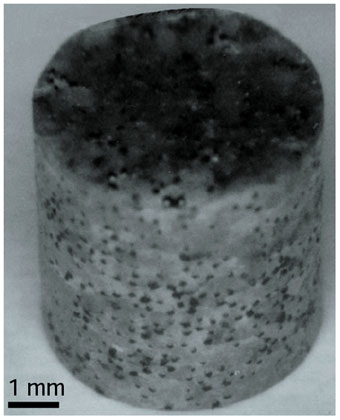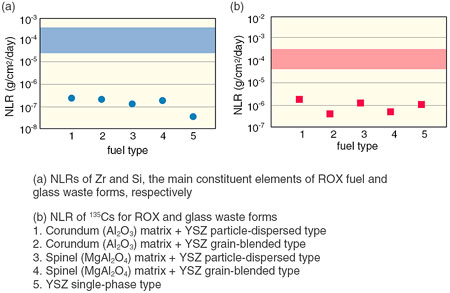Plutonium (Pu) is a valuable nuclear fuel resource. However, Pu has high toxicity and is a material for nuclear weapons. Nonproliferation technology for Pu disposal that has excellent environmental safety is required if the amount of Pu from reprocessing greatly exceeds Pu consumption in reactors, if large quantities of weapons-grade Pu are obtained from dismantled warheads, or both. Addressing these concerns, we have been studying and developing a once-through type Rock-like Oxide (ROX) fuel (Fig. 1-9) for efficient Pu burnup in conventional LWRs and direct disposal of the chemically stable spent fuel, without further processing. Unlike UO2 and mixed oxide (MOX) fuels, almost complete Pu burnup in ROX fuel is possible because ROX fuel does not contain U that produces Pu. In addition, spent ROX fuel is expected to be stable as a waste form and disposable in a deep underground repository because ROX is composed of well-known geologically stable materials - stabilized zirconia (YSZ, an oxide of Zr and Y in solid solution), and spinel and/or corundum (a form of Mg and Al oxide). To demonstrate the possibility of direct disposal, a leaching test is necessary to quantify the dissolution speed of spent fuel in contact with underground water.
A leaching test for ROX fuel irradiated four cycles in JRR-3 was carried out at Waste Safety Testing Facility (WASTEF). The normalized leach rate (NLR) of Zr, a main constituent of ROX fuel, is 1/1000 or less than that of the main constituent, Si, in the glass waste form of high-level radioactive waste (Fig. 1-10 (a)). Thus, it will take about 100,000 years to dissolve completely a 1 cm cube of YSZ. Additionally, 135Cs in spent ROX fuel, a beta-emitter with an ultra long half-life and therefore an important nuclide for geological safety assessment, dissolves more slowly, by a factor of more than 100, compared with the glass waste form (Fig. 1-10 (b)). The other b-emitters with ultra long half-lives also dissolve slower than in the glass waste form. Spent ROX fuel has good performance as a waste form. The feasibility of using ROX fuel as once-through type fuel is confirmed by these results.
|


 and
and  , respectively. NLRs of Si and 135Cs for a glass waste form are zoned by
, respectively. NLRs of Si and 135Cs for a glass waste form are zoned by  and
and  , respectively. The NLR of Zr, 10-7 g/cm2/day, is 1/1000 or less than the NLR of Si, 10-4 g/cm2/day. Thus, Zr dissolves more slowly by a factor of more than 1000.
, respectively. The NLR of Zr, 10-7 g/cm2/day, is 1/1000 or less than the NLR of Si, 10-4 g/cm2/day. Thus, Zr dissolves more slowly by a factor of more than 1000.